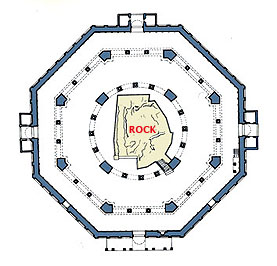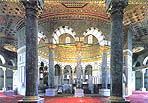|
DOME OF THE ROCK
|
TAKEO KAMIYA
|
DOME OF THE ROCK
|
TAKEO KAMIYA


Being the first monumental building for Muslims, the architecture of Islam had not yet been established; they accordingly adopted the methods of Byzantine arts and architecture on a large scale, which were the tradition of this region. They formed a rounded continuous arcade over the row of alternate pillars and columns, embellishing the walls with splendid gold-based glass mosaics, the patterns of which were composed with representational objects like trees, grapevines, crowns and so on, having not yet developed geometric arabesque.
However, a line of calligraphy makes a circle above the arcade, praising the glory of God and proclaiming that Muhammad was the apostle of God. It was a previous notice of the fact that calligraphy would grow to a main element of the Islamic ornamentation afterward.
  Interiors of the Dome of the Rock and the Santa Costanza Its architectural formation is pointed out to deeply resemble the Christian Church of the Holy Sepulcher located near here; being a rotunda with double ambulatories, its diameter is 20.4m, combined and facing a basilica-type chapel (one is the church of Resurrection and the other is the al-Aqsa Mosque). In short, the Dome of the Rock was under deep influence of Syria-Byzantine arts and architecture, whose appearance suggests that the Umayyads invited specialists of the preceding civilization, from architects to mosaicists. In every area which Islam expanded, Muslims thereby succeeded the previous civilization, developing gradually their own architecture. (In "Architecture of Islam" 2006) E-mail to: kamiya@t.email.ne.jp
|